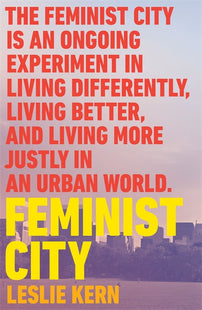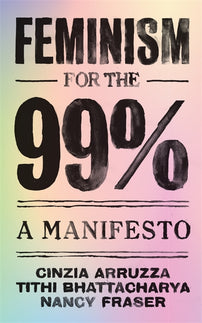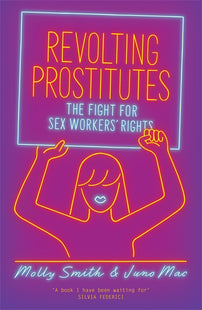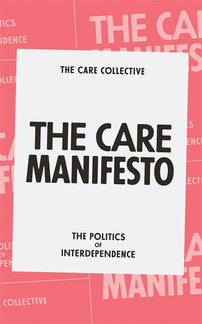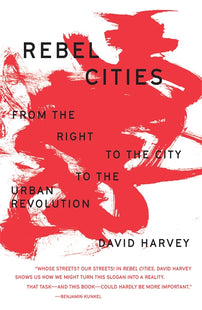The Non-Sexist City
Leslie Kern asks how we can create a feminist city and what tools women can use to support each other.

Visions of the “non-sexist city” often centre housing issues, noting that the nuclear family home is a really inefficient way to utilize labour, one that keeps women tied to the home with little time or energy for other pursuits. Housing developments that allow households to share the work of cooking, cleaning, and caring for children are common features of feminist designs. Some of the work of imagining the non-sexist city has already been done.
When I started my master’s degree with a child under one year of age and no way to afford daycare, I scrambled to find time to complete my work. Luckily, I met Anneke. We had classes together and discovered that we were both the primary caregivers for very young kids. I started bringing Maddy to Anneke’s house two days a week and we took turns watching the kids while one of us left for a few hours to study. The little bit of extra time afforded by what I liked to call the “city’s smallest babysitting co-op” made a huge difference. At the time, I thought that we were just lucky. I didn’t realize that we were part of a long tradition of mothers and other caregivers coming up with ingenious arrangements for doing care work in the city. These creative practices of “getting by” have informed feminist urban interventions since the nineteenth century.
Yet, many decades after trenchant critiques of how cities and suburbs fail mothers and other caregivers, the same problems remain. Under neoliberalism, most of the “solutions” generated for those problems have been market-based, meaning they require the ability to pay for extra services, conveniences, and someone else’s underpaid labour. Very few changes have re-imagined and re-worked the built environment and other aspects of urban infrastructure in ways that take care work seriously.
In Europe, “gender-mainstreaming” approaches to urban planning and budgetary decisions have a longer history. Essentially, these frameworks mean that every planning, policy, and budget decision has to be considered with the goal of gender equality as the departure point. For example, policymakers must ask how a decision will potentially enhance or undermine gender equality. These approaches push cities to consider how decisions support or stymie the care work that literally keeps society functioning.
The city of Vienna has adopted a gender mainstreaming approach in several areas, such as education and health care. But it has had a profound affect on urban planning. Echoing the experiences of women around the world, and my own experiences too, women responded to a 1999 transit survey with their stories of complex journeys balancing care and paid work: “I take my kids to the doctor some mornings, then bring them to school before I go to work. Later, I help my mother buy groceries and bring my kids home on the metro.” Transit use illustrated some of the vast discrepancies between men’s and women’s use of city services and spaces. Vienna attempted to meet this challenge by redesigning areas to facilitate pedestrian mobility and accessibility as well as improving public transport services. The city also created housing developments of the sort imagined by feminist designers, including on-site childcare, health services, and access to transit. With the objective of making sure that everyone has equal access to urban resources, Vienna’s gender mainstreaming approach is “literally reshaping the city.”
Taking a gender-centred perspective on planning doesn’t have to be limited to wealthy global north cities. Women in informal settlements in global south mega-cities are also working to reclaim urban planning. Faced with critical challenges such as poverty, lack of secure tenure, poor sanitation, and few sexual and repro- ductive health services, women have often banded together to form collectives that help them improve economic opportunities and advocate for security of housing and tenure. For example, the Shack Dwellers Federation of Namibia is a collective offering “shared security of tenure and housing to their members, thereby improving women’s opportunities to get better public services and generate income.” Prabha Khosla identifies “gender-sensitive slum upgrading” as an area of action, noting that women must be included as decision-makers to ensure access to affordable land, with close proximity to work and essential services.
Gender mainstreaming is slowly making its way into more cities. Recently, news media seemed amused to report that some Canadian and U.S. cities were using a gender analysis on their snowplow budgets and schedules. While it’s fair to say that snow doesn’t discriminate, decisions about which roads and areas to prioritize for clearance reveals a lot about which activities are valued in the city. In most cases, cities plow major roads leading to the central city first, leaving residential streets, sidewalks, and school zones until last.
In contrast, cities like Stockholm have adopted a “gender equal plowing strategy” that instead prioritizes sidewalks, bike paths, bus lanes, and day care zones in recognition of the fact that women, children, and seniors are more likely to walk, bike, or use mass transit. Moreover, since kids need to be dropped off before work begins, it makes sense to clear these routes earlier. The vice mayor of Stockholm, Daniel Helldén, described the plan to Canadian media, arguing that instead of plowing in ways that reinforce car-centred behavior, Stockholm’s method encourages everyone to use alternative modes of trans- portation. Instead of replicating the status quo, their plan looks forward to “how you want your city to be.”
Gender mainstreaming has its limitations. City officials in Vienna note there’s a danger of reinforcing already existing gender norms and roles around paid and unpaid work. For example, in Seoul, efforts to make working women’s commutes easier—with everything from “high heel friendly” pavements to “pink” parking spots designated for women—have not been matched by state efforts to balance inequities in domestic and childcare labour. Taking gender as the primary category for equality can also be limiting. While the typical urban citizen has too often been narrowly imagined as a white, cis, able-bodied, middle class, heterosexual man, the imagined female citizen of gender planning has been similarly limited. A married, able-bodied mother with a pink- or white-collar job has usually been the imagined beneficiary of gender-sensitive planning. This woman is increasingly likely to represent a minority in most contemporary cities, suggesting that there are large groups of women whose needs may be unmet by gender mainstreaming.
Travelling outside of the central city illustrates these disparities and their spatial components. When I started my PhD, my commute up to York University on the Keele Street bus took me through low-income, racialized neighbourhoods where even more outrageous demands on mothers became apparent. Although still technically urban, these are neighbourhoods where walking to a full-service grocery store is rarely an option. Taking public transit means waiting unsheltered in the freezing cold or blazing sun for inaccessible, unpredictable buses. Fulfilling daily needs means making multiple stops at different shops and strip malls. The prospect of these moms finding thirty minutes to read the paper in a Starbucks during the baby’s nap seemed highly unlikely.
Geographer Brenda Parker writes compellingly about the experiences of low-income African American women in Milwaukee. Parker argues that gentrification and cutbacks to urban social services result in “amplification” and “intensification” effects on the everyday lives and labours of these women, effects that get written on the body in the form of exhaustion, illness, and chronic pain. Navigating the city isn’t just tiring in terms of negotiating treacherous stairs and overcrowded transit. These inconveniences are layered with the time- and energy- sucking work of navigating both “state and ‘shadow’ provisioning options, such as travelling to food pantries and churches; meet- ing with social workers, teachers, and food stamp offices; and the endless waiting at agencies and health clinics.”
Combined with over extended, poorly paid workdays, this labour meant that even the basic responsibilities and joys of parent- hood fell out of reach. One of Parker’s interviewees, “Audra,” shared her experience: “Because you’re spending fourteen hours a day on an eight-hour a day job. So when you get home you’re too tired to help them with their homework.”
These struggles are only exacerbated by gentrification. Low-income racialized women are more vulnerable to displacement, getting pushed into under-serviced areas where the benefits of urban living—inter-connected access to places of employment, schools, services, retail, transit, and home life—are decidedly thinned out.
These areas may also be zones where air pollution and issues such as contaminated water further affect the work of mothering. Urban environmental geographer Julie Sze writes about the high rates of respiratory illness among children of colour in poor neighbourhoods, where mothers are centrally responsible for the intensive work of asthma management. The struggle to provide clean water for drinking, cleaning, and bathing in the context of the Flint water crisis is another example, not to mention the work of caring for children affected by lead poisoning. As the work of motherhood becomes costlier via the gentrification of parenting, those who can afford privatized services benefit while those who cannot are shoved into neighbourhoods that make their lives even harder.
In Milwaukee, the racially-divided geography of the city also affected mothers’ abilities to find good work close to home. Research with mothers in Johannesburg found that the legacies of apartheid and its lingering geographies of segregation contin- ued to shape the choices mothers make with respect to home, work, and school in the city. For example, great disparities in the quality of schools, reflecting raced and classed geographies, meant that many mothers had to consider uprooting in order to move within the catchment range of a good school, even if that meant losing out on employment opportunities and family support. Dangerous public transport systems also meant that mothers were reluctant to send their children alone, meaning that they had to juggle work and home alongside school travel.
Confronted with a dearth of support from city policy and infrastructure for their lives, low-income women are forced to find ways to weave care and paid labour together. In Parker’s Milwaukee research, women “took their babies with them while they drove the bus for work; . . . not uncommonly, two or three families lived together in a one- or two-bedroom apartment. There, women watched each other’s children while one person ‘provisioned’ the household through paid labor.” In Johannesburg, women sometimes made the heartbreaking decision to have their children live with relatives because the limited range of choice in places to live and work hampered their ability to give their children access to amenities or good schools.
These kinds of strategies have long been described by Black feminist writers like bell hooks and Patricia Hill Collins, who contend that Black women’s social reproductive work has mostly been subject to punitive measures by the state, such as having children taken away or being subject to “workfare” policies. Feminist activism around domestic labour has typically centred the white, heterosexual married woman and ignored the particular needs and concerns of women of colour.
While it can be dangerous to romanticize the survival strategies of low-income people of colour, their tactics and resistance strategies push feminists to think beyond gender mainstreaming. In Urban Black Women and the Politics of Resistance, Zenzele Isoke explores how Black women resist and rework the meanings of urban space and urban politics in what she calls a “despised” city: Newark. Facing long-term disinvestment in their communities and high levels of state violence, Black women in Newark, argues Isoke, use practices of “homemaking” in the city to reconfigure a “hostile and deeply racialized landscape.” Here, homemaking means “creating homeplaces to affirm African American life, history, culture, and politics. Homeplaces are political spaces that black women create to express care for each other and their communities, and to remember, revise, and revive scripts of black political resistance.” An urban politics of care is enacted not only through an attachment to place, but as “an active and collective working toward physical, symbolic, and relational transformations.”
As a state-centred, “single issue” strategy, gender mainstreaming can only take us so far. And let’s face it, relying heavily on the state for radical transformation is a waste of time, and perhaps even dangerous for Black and Indigenous people and people of colour who have been deemed expendable or positioned as “problems” to be solved or disposed of in the “progressive” city. Isoke’s study illustrates the power of forging alliances across diverse communities to combat racism, sexism, and homophobia to “confront and transform [the] structural intersectionality” of oppressions in the city. I want cities to enact policies and create spaces that make care work and social reproduction more collective, less exhausting, and more equitable. However, I know we have to look for deeper change and are expansive and liberatory imaginings of the city in the spaces and communities that are already practicing ways of caring that bust the binaries of paid and unpaid work, public and private spaces, production and social reproduction.
What would care-full urban futures look like? Futures that were based around the needs, demands, and desires of women of colour, disabled women, queer women, single women care- givers, aging women, Indigenous women, and especially those for whom these identities intersect? It’s clear that the time has come to decentre the heterosexual, nuclear family in everything from housing design to transportation strategies, neighbourhood planning to urban zoning. This means that city planners and architects can’t take the white, able-bodied cis man as the default subject and imagine everyone else as a variation on the norm. Instead, the margins must become the centre. Although the lives of an aging widow in the inner suburbs and low-income lesbian moms renting in a gentrifying neighbourhood will look different, interventions to improve access to city services and amenities for one will likely benefit the other. Accessible transportation, plowed sidewalks, affordable housing, safe and clean public bath- rooms, access to a community garden, a liveable minimum wage, and shared spaces for things like meal preparation would relieve burdens on many kinds of households, not to mention contribute to other important goals such as environmental sustainability.
A feminist city must be one where barriers—physical and social—are dismantled, where all bodies are welcome and accommodated. A feminist city must be care-centred, not because women should remain largely responsible for care work, but because the city has the potential to spread care work more evenly. A feminist city must look to the creative tools that women have always used to support one another and find ways to build that support into the very fabric of the urban world.
[book-strip index="1" style="display"]